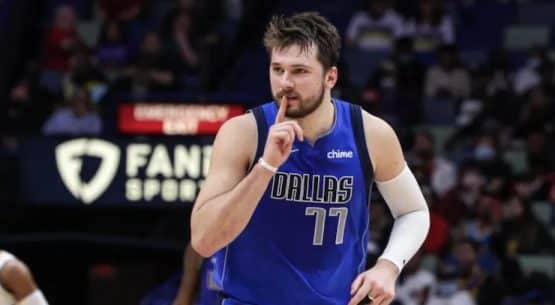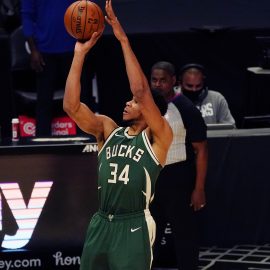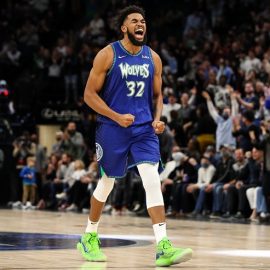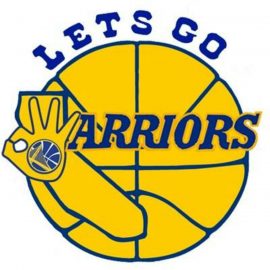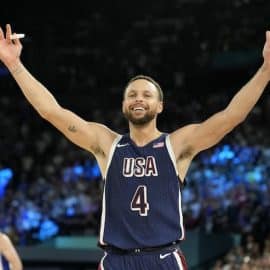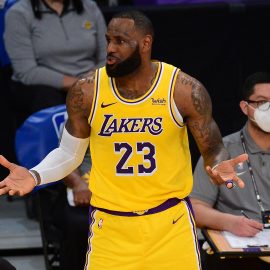It seems like a very long time ago that Larry Bird made the decision to not renew the contract of Frank Vogel as head coach of the Indiana Pacers. On that day in early May, there was some level of disbelief and a mixture of contempt and animus toward Bird for making that decision. Some time has passed and maybe it ended up being the best move for everyone.
Bird was always up front about wanting the Pacers to be a much more effective team on the offensive end of the court. It was also quite clear that Indiana lacked any consistent offensive weapons outside of guard-forward.
George was only one year removed from an injury that bordered on horrific, when he broke his leg at a Team USA camp in the summer of 2014. However, he bounced back in 2015-16 and led the Pacers with 23.1 points per game. That’s not a bad start for a team that wants to run heavy on the offensive end of the floor. But there was a problem with that plan.
The second-highest bucket maker was Monta Ellis with 13.8 points and, as an 81-game starter at guard, just. Ellis is a streaky shooter, with a reputation as a known ball-dominant guard that stops possessions and favors shooting to distributing.
After the announcement that Bird was not going to bring back Vogel, there were many explanations as to why that decision was particularly poor. Vogel is one of the best defensive coaches in the league. Further, after pushing his Pacers teams to the possible levels of success in the LeBron-era of the Eastern Conference, he lost multiple pieces of his contender to free agency and injury. Then, Roy Hibbert vanished, a shell of the all-world defender he had once been.
Enter Nate McMillan. The ex-player has been on coaching staffs in some capacity dating back to the end of his playing days in the late 1990s. He was head coach of both the Seattle SuperSonics and the Portland Trail Blazers before joining the Indiana staff as an associate head coach under Vogel.
Impressively, McMillan has a career winning percentage of .514, despite coaching teams that were generally unspectacular, save for the 2004-05 SuperSonics team that finished with a regular season record of 52-30. Seattle bounced the Sacramento Kings in the first round that year, but then ran into the San Antonio Spurs.
That particular season might be a great reference point for what would be considered a best-case scenario for a team under the guidance of McMillan. Even if we give McMillan maximum credit for taking a sub-.500 team the year before and molding them into the best team in their division, there was some good fortune that played in to this. Notably, they outperformed their expected record by four wins. It may not seem like much, but that is definitely overachieving.
Four more losses for the Pacers in 2015-16 could have moved them completely out of the playoffs, making the decision to move on from Vogel significantly less scrutinized. Conversely, four more wins would have moved them into the No. 3 seed in the playoffs and perhaps Bird would have been forced to the table for negotiations to keep one of the best coaches in franchise history.
That 2004-05 Seattle team was a great example of exactly what McMillan has to offer, both good and bad. The good is the offense. McMillan’s Sonics squads were consistently among the best in the entire league when measured by offensive rating. During that 52-win season, Seattle boasted an offensive rating of 112.2, good for second in the association. The bad is the defensive rating. That same Sonics team carried a defensive rating of 109.6 – 27th, or fourth worst in the entire league.
This stretched beyond a single season for McMillan, year-over-year numbers in Seattle showing that while the defense may not have always cratered like the ’04-05 season, it was never better than middle of the pack. His SuperSonics years were always led by offense.
The pattern continued when McMillan moved to Portland the following season. It took a considerable amount of time, but the improvement was visible, as his Blazers squad improved from 21 wins during his first season in charge to 54 wins in his fourth season, 2008-09.
That season was the best McMillan ever had as a coach. Not only was the tally of 54 wins his best as a coach, but Portland had the best offensive rating in the entire league, 113.9, and were 13th in defensive rating, 107.8. This is the McMillan that Bird is gambling that he will get in 2016-17.
Somewhere between the excellent offense of his peak teams in both Portland and Seattle, the Pacers are hoping to become a scoring threat once again. The data that supports his defensive squads as somewhere between lacking and merely competent is going to be a real obstacle. However, Bird doesn’t believe this.
During his press conference, Bird referenced keeping on some of the associate coaching staff. He also credited that group with the defensive results. It was both a sideways shot at the departing Vogel and a vote of confidence in the defensive system he believes will remain in place despite the change of head coach.
The Vogel decision didn’t sit well with many in the dark corners of the internet that are occupied by basketball bloggers, staff writers, editors, statisticians and the generally inflammatory hoop fanatics of the world. It wasn’t just in that dark place that spends every waking moment of every day talking basketball. The decision was also difficult to swallow for many in the mainstream.
Bird carried the expectation that Vogel was going to improve the offense. At his disposal was a recently healthy George and shoot-first, streaky Ellis. Building a top-tier offense needs more than just those two players and some combination of Ian Mahinmi, rookie Myles Turner, George Hill and Rodney Stuckey.
Sure, the Pacers had a full roster and other players to work with, but they definitely didn’t have the kind of scoring options to make this team work with an offensive emphasis. Bird knew this, so when McMillan was hired, Indiana set about reconstructing the team.
Earlier, Ellis’ poor scoring numbers were referenced. It is worth pointing out that his scoring in 2015-16 was a full 4.9 points below his career average. In fact, it was his worst scoring season since he was a rookie in 2005-06 with Golden State. Even with his down season included, his career points per game is 18.7 and it is reasonable to make the assumption that he will be closer to that number in 2016-17. Ellis was also in his first season with the Pacers last year, which may have been a contributing factor.
Another truth is that age might simply be catching up with Ellis, who already has over a decade of NBA experience and is on the wrong side of age 30.
The Pacers may have sensed the direction Ellis is heading. During the summer, Indiana acquired Jeff Teague via a three-team trade that sent George Hill to the Utah Jazz. Not done there, the Pacers also signed free agent Aaron Brooks, who spent the previous couple seasons with the Chicago Bulls. Both players represent great options at point guard.
Teague is still a highly valuable point guard, capable of leading a team as a starter. Brooks is coming off a role as the Derrick Rose backup who is going to inevitably end up starting a whole bunch of games when Rose gets injured again. He shouldn’t be a starter anywhere for a full season, but in a limited role he has a lot to offer. Particularly, his offensive spark off the bench and ability to catch fire at just the right time. Bringing in both of these players means that Ellis is going to be removed from his ball-stopping duties permanently, hopefully. Instead, he will be free to move without the ball and employ his favorite skill – shooting, shooting, shooting.
Indiana also has a big boost coming from second-year center, Myles Turner. But, they know that they needed more so they went out and signed Al Jefferson, fresh off a shaky season in Charlotte. When he looked good, it was really good and when he was off, it was most of the way off. Jefferson ate up a lot of Eastern Conference defenders when he was feeling it. His back-to-the-basket game is still quite strong, a reliable source of offense. His size forces help defense when he gets rolling, opening up a lot of space for shooters.
Turner is likely the starter, but Jefferson adds the perfect wrinkle – a big with a deft touch on the offensive end of the floor that can give you scoring quickly. That, of course, is a theme with the addition of Brooks as well. So a pattern emerges with some of the activity for the Pacers in the offseason. Create a bench that is capable of scoring quickly and often, but also composed of players who are capable of taking starting duties when needed, though they shouldn’t be put in that position as a primary option.
The Pacers also made a trade to acquire the services of Thaddeus Young from the Brooklyn Nets. Young is a solid 15 points, nine rebounds type power forward that does all the things you need without all the side effects that normally come with those numbers. Think 15/9 from Pau Gasol or Carlos Boozer without the constant yelling, slow release and general defensive ineptitude.
All of these new pieces in Indianapolis probably would have thrived quite well under Vogel, but McMillan is here now and this is a team built to his specifications. He is blessed with having one of the best two-way players in the entire league, a borderline Eastern Conference-level all-star guard (read: wouldn’t even crack top 10 guards in the West), competent backup backcourt options, and an above average backup center on the offensive end of the floor.
Looking ahead to 2016-17, the Pacers are well-positioned to either maintain or take a small step forward. Their 45-37 record was boosted by the third best defensive rating in the league at 102.9 while their offense was nearly non-existent, finishing 25th in the league at 104.6.
The expectation will be a major regression on the defensive end of the floor, but even dropping from third to 13th could be manageable. It all depends on what they can do on offense under McMillan. The projected starting lineup as of today would be Teague, Ellis, George, Young and Turner. The first off the bench tandem probably ends up as Brooks and Jefferson. That combination gives them essentially replacement-level substitutes that produce better than replacement on the offensive end of the court.
The improved starting five and the offensive firepower on the bench keeps Indiana relevant while teams like Miami, Charlotte and Atlanta are likely to regress. Despite the many changes to the roster and the head coach switch-out, I’d still tag Turner as the key development for the upcoming season. If he can avoid a sophomore slump and take a big step forward in his game, their frontcourt rotation will be one of the more productive combinations in the East.
This could all go spectacularly wrong if McMillan fails to connect with his players, the floor completely drops out from under the defense, or injuries pile up. It doesn’t seem likely that the first two will happen, McMillan was already in-house under Vogel, and the third is an unknown quantity. It looks like the Pacers are well-positioned in the race back to the playoffs this season.
Add The Sports Daily to your Google News Feed!
